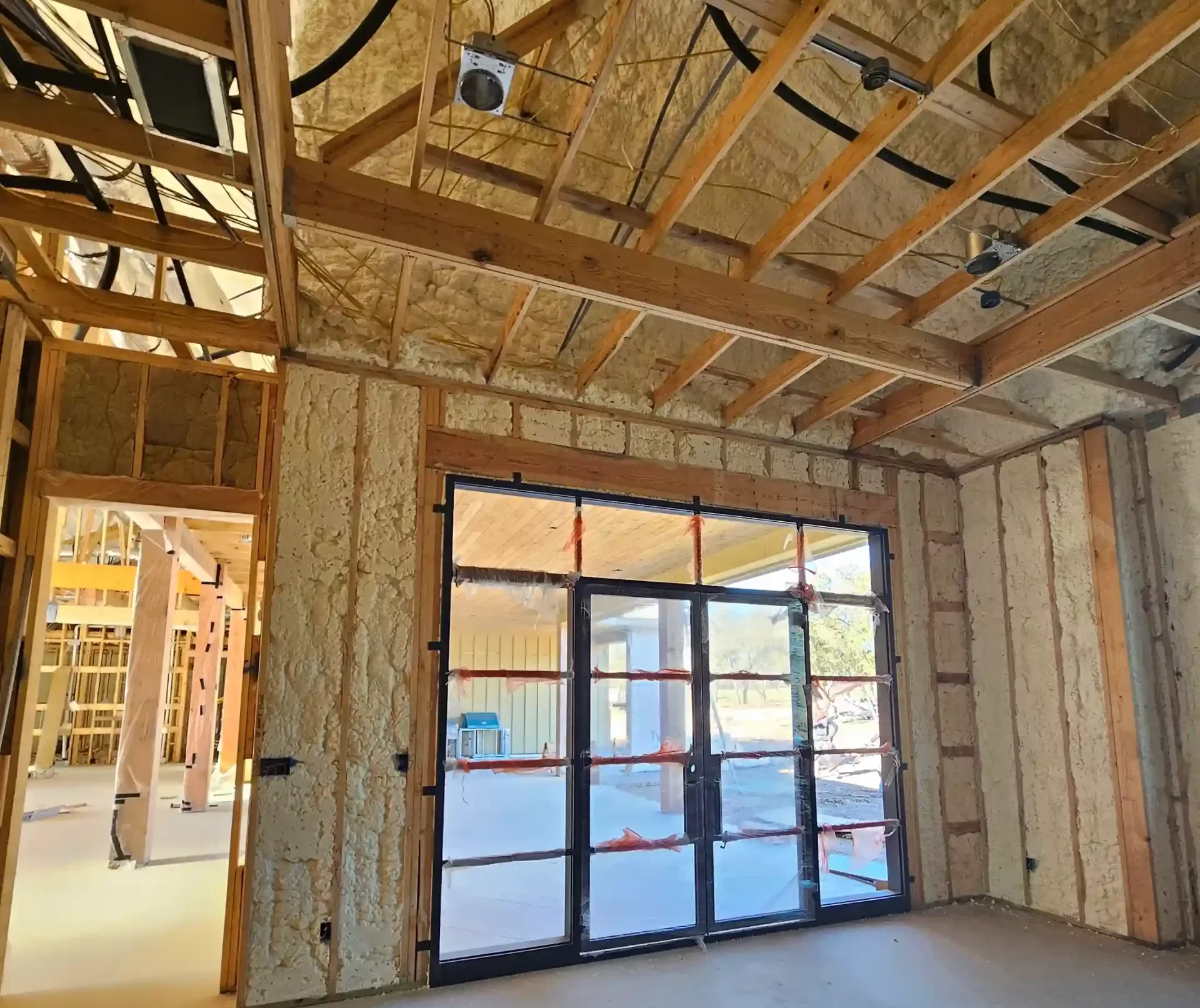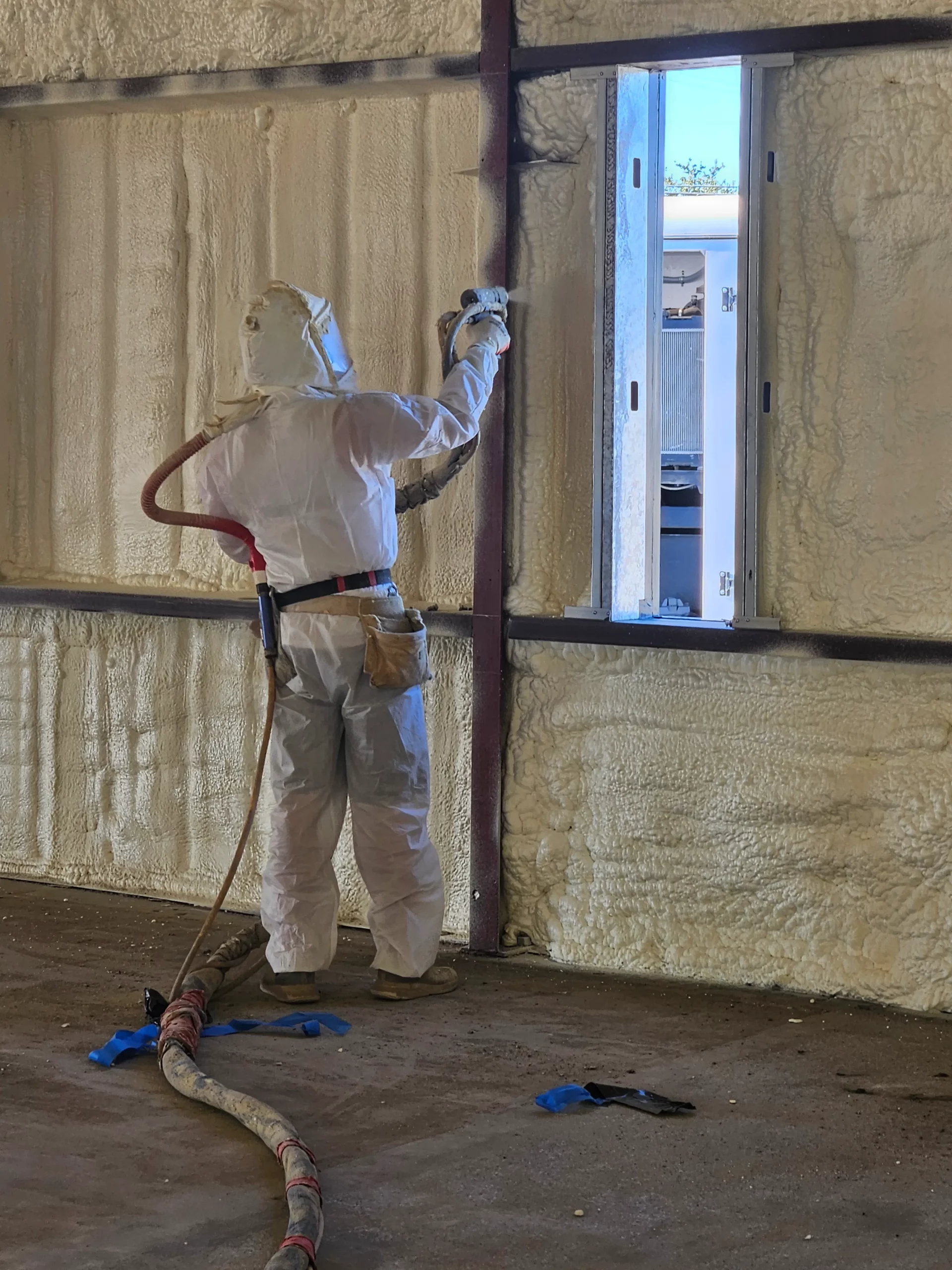

Spray foam insulation creates an airtight thermal barrier that significantly reduces heat transfer, keeping Texas homes cooler during scorching summer months. The material expands upon application to seal air gaps and cracks that allow hot outdoor air to infiltrate buildings, while simultaneously preventing conditioned air from escaping. This dual action can reduce cooling costs by 20-40% compared to traditional insulation methods.
Professional installation of spray foam insulation transforms how buildings respond to Texas’s extreme temperature variations. The material’s superior R-value per inch and air-sealing properties make it particularly effective in the state’s climate, where outdoor temperatures routinely exceed 100°F for extended periods. Based on extensive field experience across Texas installations, spray foam consistently outperforms fiberglass and cellulose insulation in maintaining comfortable indoor temperatures while reducing energy consumption.
Spray foam insulation operates through two primary mechanisms that combat Texas heat effectively. The material creates a continuous insulation layer that minimizes thermal bridging—the process where heat travels through structural elements like studs and joists. Traditional batt insulation leaves gaps around these structural components, creating pathways for heat transfer that spray foam completely eliminates.
The expansion properties of spray foam allow it to conform to irregular surfaces and penetrate into cracks as small as 1/64 inch. This comprehensive coverage addresses the reality that most heat gain in Texas buildings occurs through air infiltration rather than pure conduction. When outdoor temperatures reach 105°F, even minor air leaks can dramatically increase cooling loads.
| Insulation Type | R-Value per Inch | Air Sealing Capability | Heat Resistance at 100°F+ |
|---|---|---|---|
| Closed-Cell Spray Foam | 6.0-7.0 | Complete seal | Excellent |
| Open-Cell Spray Foam | 3.6-4.0 | Good seal | Very Good |
| Fiberglass Batts | 2.2-2.7 | Minimal | Poor |
| Cellulose | 3.2-3.8 | Moderate | Fair |
Bonus Tip: Spray foam’s closed-cell structure also acts as a vapor barrier, preventing moisture-laden Texas air from condensing inside wall cavities and compromising insulation performance.
Texas presents unique challenges that make spray foam particularly valuable compared to other regions. The state experiences temperature swings of 40-50°F between night and day during summer months, creating constant expansion and contraction cycles in building materials. Spray foam maintains its seal integrity through these thermal cycles, while traditional insulation materials can shift and create gaps.
The combination of high heat and humidity characteristic of Texas summers creates additional stress on cooling systems. According to the Electric Reliability Council of Texas (ERCOT), residential air conditioning accounts for approximately 60% of peak electricity demand during summer months. Spray foam insulation directly addresses this demand by maintaining consistent indoor temperatures with less mechanical cooling.
Regional installation experience demonstrates that spray foam performs exceptionally well in Texas’s diverse climate zones, from the humid coastal regions to the arid western areas. The material’s performance remains consistent across temperature ranges from 20°F winter lows to 115°F summer peaks commonly experienced throughout the state.
The effectiveness of spray foam in Texas heat depends significantly on proper application thickness and density. Field measurements from installations across Texas reveal optimal performance characteristics that building owners should understand.
| Application Parameter | Closed-Cell Foam | Open-Cell Foam | Performance Impact |
|---|---|---|---|
| Minimum Thickness | 2 inches | 5.5 inches | Adequate thermal barrier |
| Optimal Thickness | 3-4 inches | 7-9 inches | Maximum efficiency |
| Density | 2.0-2.2 lbs/ft³ | 0.5-0.7 lbs/ft³ | Structural integrity |
| Application Temperature Range | 60-90°F | 60-85°F | Proper curing conditions |
Bonus Tip: Installing spray foam during cooler morning hours in Texas summer allows better application conditions and more predictable curing, resulting in superior long-term performance.

Spray Foam Tech provides comprehensive insulation solutions specifically designed for Texas climate challenges. The company’s residential spray foam services address whole-house thermal envelope improvements that deliver measurable cooling cost reductions throughout Texas’s extended summer seasons.
Commercial spray foam applications handle the unique demands of Texas business facilities, where cooling costs can represent significant operational expenses. Large-scale commercial projects benefit from spray foam’s ability to create consistent thermal barriers across complex building geometries.
Open-cell spray foam installations offer cost-effective solutions for interior applications where vapor barrier properties are less critical. This approach works particularly well for interior walls and ceilings in Texas homes where air sealing provides the primary benefit.
Closed-cell spray foam applications deliver maximum thermal resistance and structural enhancement for exterior applications. The material’s superior performance characteristics make it ideal for Texas homes requiring the highest level of heat resistance and energy efficiency.
Building owners frequently ask about application timing for spray foam projects in Texas heat. Installation during moderate temperature periods ensures optimal application conditions and proper curing. Spring and fall seasons typically provide ideal conditions, though professional installers can work successfully throughout the year with proper precautions.
Preparation requirements for spray foam installation vary based on existing conditions and application areas. Most installations require temporary relocation from treatment areas during application and initial curing periods. Proper ventilation during application ensures safe working conditions and optimal material performance.
Expected performance improvements from spray foam installation typically become apparent immediately after completion. However, maximum benefits develop over the first complete cooling season as the building envelope reaches thermal equilibrium with the improved insulation system.
Effective spray foam insulation requires professional assessment of your specific building conditions and climate zone requirements. Texas homes face unique challenges that demand experienced installation techniques and appropriate material selection for optimal heat resistance.
Spray Foam Tech brings specialized expertise in Texas climate applications, ensuring installations deliver maximum cooling cost reductions and comfort improvements. Professional evaluation identifies the most effective insulation strategies for your building’s specific heat gain patterns and existing envelope conditions.
Contact Spray Foam Tech at (737) 777-9590 or oldworldtx@hotmail.com for comprehensive evaluation of your building’s insulation needs. Professional installation ensures spray foam insulation delivers optimal performance against Texas heat while providing long-term energy efficiency benefits.
Properly installed spray foam insulation maintains effectiveness for 20-30 years in Texas conditions. The material resists degradation from temperature cycling and UV exposure when protected within building assemblies. Regular building maintenance and protection from physical damage ensure maximum longevity.
Spray foam typically reduces cooling costs by 20-40% in Texas applications through improved thermal resistance and air sealing. The exact savings depend on existing insulation conditions, building envelope quality, and HVAC system efficiency. Most installations achieve payback within 5-8 years through energy savings.
Spray foam outperforms traditional insulation materials in Texas due to superior air sealing capabilities and higher R-values per inch. The material’s ability to seal air leaks provides particular advantage in Texas, where infiltration drives significant cooling loads during extended summer seasons.
Closed-cell spray foam requires 3-4 inches for optimal performance in Texas, while open-cell applications need 7-9 inches. Thickness requirements vary based on building design, existing insulation, and specific performance goals. Professional assessment determines optimal thickness for each application.
Texas humidity levels can impact spray foam application and curing but do not significantly affect long-term performance once properly installed. Closed-cell spray foam provides vapor barrier properties that help manage moisture issues common in humid Texas climates, while open-cell applications require careful moisture management planning.


